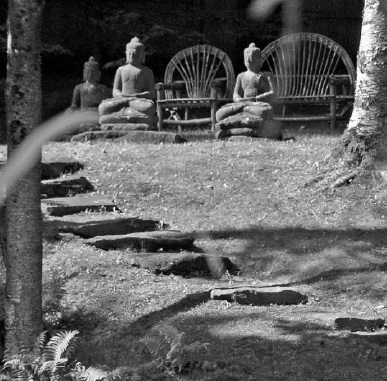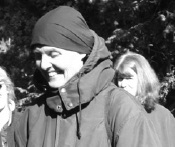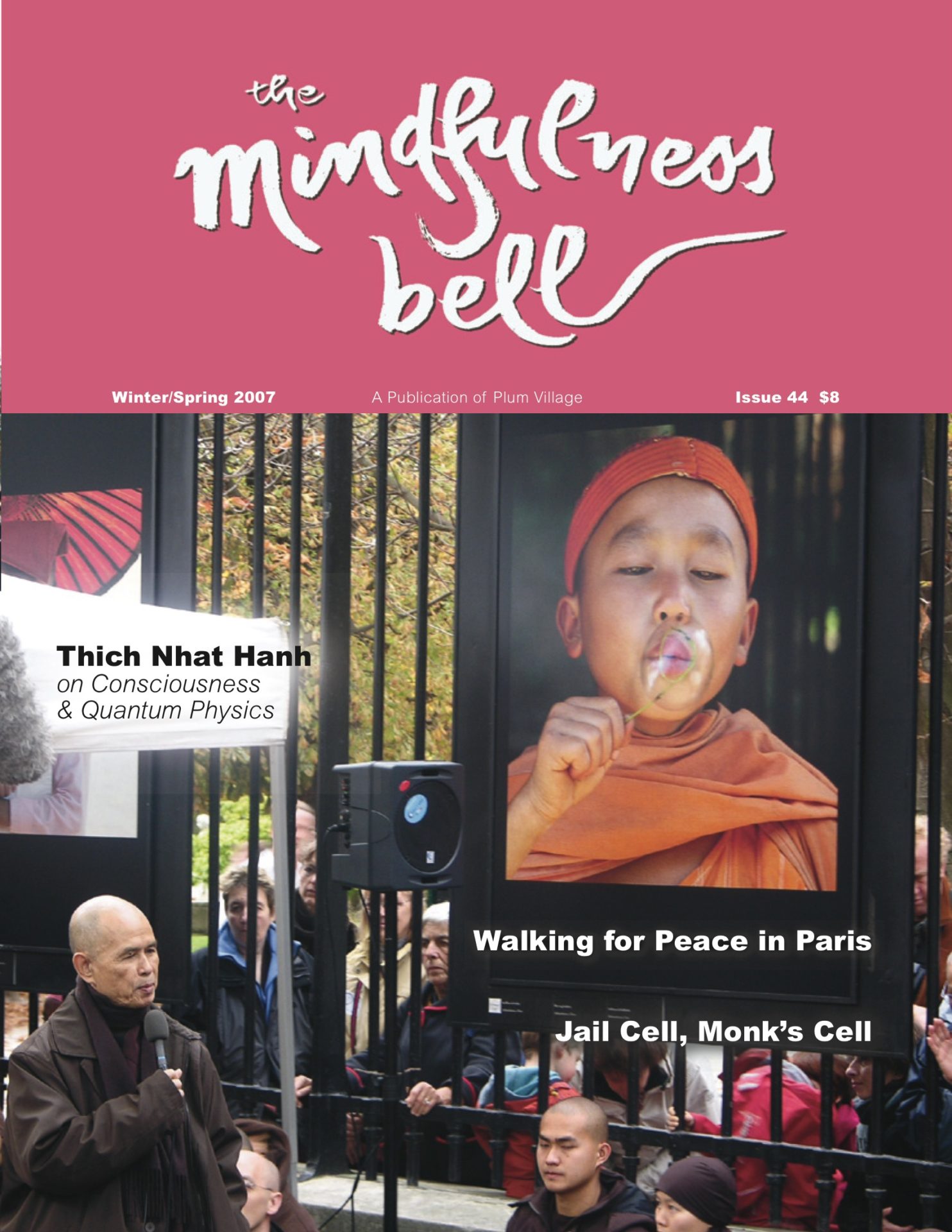
By Sister Annabel, True Virtue
In this series of essays, Sister Annabel, one of Thây’s most senior students, shares memories and insights from her life at Plum Village—and the path that led her there.
The Lower Hamlet of Plum Village somewhat resembled the farm where I grew up. It had barns, muddy lanes, fruit trees, no heating except for wood stoves, stone walls, and a vast star-filled sky at night.

By Sister Annabel, True Virtue
In this series of essays, Sister Annabel, one of Thây’s most senior students, shares memories and insights from her life at Plum Village—and the path that led her there.
The Lower Hamlet of Plum Village somewhat resembled the farm where I grew up. It had barns, muddy lanes, fruit trees, no heating except for wood stoves, stone walls, and a vast star-filled sky at night. Maybe that is one of the reasons I feel at home there. One day when I first came to the Lower Hamlet we were practicing slow walking in the Red Candle meditation hall. My eyes turned to the stone walls and suddenly I felt those stones were old friends and relatives; I had found the home that I had missed for so long. Then we went outside and I looked up to the hills of the Dordogne and I felt as if I had lived there long ago. Now I had come back.
Lower Hamlet was a place where I could walk on my own or with Be Tam. Be Tam was the third of the four children of the Vietnamese family that lived in Persimmon House. When I arrived in Plum Village Be Tam was five years old. He was entrusted to my care when his mother was busy. During our walks he would hold my hand and lead the way. In the blackberry season, he would take me to all the blackberry bushes near the house. He ate one blackberry from each bush and told me whether it was sweet or sour, good or bad. If it was sweet he would encourage me to eat one from the same bush. Be Tam believed that if one blackberry on a bush was sweet, then all the blackberries would be sweet. We never ate more than one from any bush and then we picked all the ripe ones. Actually the degrees of sweet and sour were very subtle because he ate each blackberry with mindfulness. Every blackberry does indeed taste different when you eat slowly and mindfully. Every blackberry is a miracle of earth and sky.
Be Tam was born in France but at five years old he had not had contact with French society, so he was more of a Vietnamese boy than a French boy. In the kitchen we had a washing machine. It had a transparent glass door so that you could see the water and the soap and the clothes as the machine washed them. Be Tam enjoyed watching this process very much. Whenever he came into the kitchen and someone was washing clothes, he would bring a chair and place it right in front of the washing machine. He would sit still, watching the process from beginning to end. It made me think that in previous life times he had not met a washing machine. I do not know what was happening in his mind as he watched but I remembered that as a child I had looked into a kaleidoscope; the miracle of its changing shapes and colors never grew stale. Maybe the washing machine was a kaleidoscope for Be Tam.

Biscottes for Breakfast
In those days in Plum Village we were not rich. The doors were opened once a year for the summer family retreat, from July 15th to August15th. During this time we hoped to receive enough donations to last us throughout the year.
During the first summer opening we just had biscottes and tea for breakfast. [A biscotte is a commercially packaged bread, toasted to a crisp golden brown. Editor] The reason we had biscottes was because the owner of a biscotte factory was a lay practitioner of Plum Village and he donated them. We were never hungry, though. When I came to Plum Village I learned to eat in mindfulness. Eating in mindfulness I appreciated Vietnamese food. I learned to see how precious food is. For someone who has known real hunger each mouthful is very precious.
During my first weeks at Plum Village, I was sitting next to Thây one day at lunch. At that time I had the habit of not eating every grain of rice on my plate. Thây said to me: “Thây sees that you know how to use the chopsticks well and could pick up every grain of rice on the plate.” Eager to please, I did just that, although I did not know why Thây was telling me this. Then Thây continued: “In Vietnam the mothers always tell their children that if they do not eat every grain of rice in their bowl, in the next life they will be born as ducks and need to go around picking up every grain of rice that they had thrown away in this life.” It is not only because we are aware of what hunger means that we do not want to leave a single grain of rice. We also understand through our practice of mindfulness that cultivating rice is not an easy matter. Much effort and some suffering goes into the making of every grain of rice.
One day Thây picked a large quantity of blackberries and asked me to make jam with them. I did not need much encouragement to make jam. My mother and grandmother had always made jam at home: blackberry, damson, apple, marrow and ginger, raspberry, apricot jam with the kernels—a few floating on the top of each pot—and bitter orange marmalade. I felt very at ease making jam and when the plum trees were mature enough to produce their first fruits, I made plum jam; there were not enough then to dry and make prunes. The wild blackberries and apples were made into jelly and on the walking meditation path there were quince trees. The Lower Hamlet had the most delicious apples, which we stored for the winter months.
A Sacred Place
The simplicity of Thây’s way of life has always been apparent. Although Thây has not always been able to live in a monastery, Thây’s place of abode always has the simplicity of the truly monastic way of living. The hermitage where Thây has been based since the founding of Plum Village now serves as a cloistered environment for the monastic sangha. It is a large house with a large garden. Before Thây lived there it was the home of a school mistress. From the outside the house does not look very special. It withdraws a little from the narrow road, secluded by old trees.
The extraordinary ambiance of the house comes from the practice. Everywhere there is a restful feeling, a freshness. Thây has planted deodara cedar trees, a bamboo grove by the stream, and other shrubs. There is a very fragrant old rose that Thây has named Elizabeth, after the previous owner of the house. The part of the garden furthest from the house is planted with poplar trees; their straight trunks are a place to suspend hammocks. The deodara trees, whose wood is used in India to make statues of the gods, are the object of Thây’s particular care. These trees frequently practice hugging meditation with Thây and his disciples.
The hermitage is not grand or luxurious but it is a place that is loved. Thây has loved this place with every footstep and every breath. Sister True Emptiness [Sister Chân Không] has loved it with her commitment to helping others by sending letters and parcels, or making telephone calls to those in need. When a place is loved like that, it becomes lovely. Just as a person who is loved and understood can blossom, so a place—a garden and a house—can become a sacred place.
Lessons from Ants and Prayer Wheels
At Lower Hamlet, I was enjoying Sister Thanh Minh’s help in the vegetable garden.
There were two other reasons that made me happy for Sister Thanh Minh’s arrival. One was that she was vegetarian and the other was that she was always ready to teach me to speak Vietnamese. She would point out to me the different objects and call them by their Vietnamese names.
When you learn a language, you also learn a culture and a way of life. Thây said that Sister Thanh Minh was very Vietnamese; she had had virtually no contact with the European way of life. Looking at her I was looking at someone who was no different from the people who were living and had lived all their lives in Vietnam.
Sister Thanh Minh came in May and it was still quite chilly at night. When she complained of being cold, I thought that the problem would be easy to solve. I gave her more blankets. She told me that the weight of the blankets stopped her from sleeping. My first reaction was to think that this was a little absurd, because I had grown up in a cold bedroom where the thick woolen blankets were piled on top of us in the winter. To me this was something perfectly natural. When I reconsidered, I saw that in south Vietnam a bed consists of a rush mat, a thin covering on the coldest days, and a mosquito net. Even one woolen blanket could feel unbearably heavy.
Plum Village is a multicultural community; many of us are people of two or more cultures. It is easy to judge what is different as incorrect. And it is wonderful to learn how not to react to what is different as being incorrect. When I was a child and spent summer holidays in France and later when I lived in Greece and then with a community of Tibetan nuns in India, I had opportunity to learn to be open to other ways of life. Learning languages and how to live in different cultural situations was something very enjoyable as long as I did not feel threatened by the difference.
It had been a challenge when I lived in India. The first thing I had to learn was always to keep my feet tucked in under me when I was sitting. Then as a lay woman I could never sit or stand in a place that was higher than a monk or a nun. If a nun wanted to go under our hut, which was on stilts, to fetch something, I would need temporarily to leave the hut. I should never say, even as only a supposition, that something bad might happen, because the very saying of it would make it more likely that that event would occur. I should never wear someone else’s shoes or allow someone else to wear my shoes. Seeing a dead mouse or rat was a bad omen; this never seemed to be so in my own case but as far as the Tibetan nuns were concerned, whenever they saw a dead mouse or rat, something went wrong for them. I should recite the sutras in Tibetan (because the English was not available), and even though I did not understand a word of what I was reciting, it would be very beneficial for my practice. One time when an ant was crawling over the sutra text I was reciting, I was told that this encounter of the ant with the written word of the sutra meant that the ant would be in touch with the Buddhadharma in a future life.
The prayer wheel was something else that I did not understand. The entrance to the monastery across from us on the other side of the valley had a gate like a turnstile that was in effect a prayer wheel. In order to enter the monastery by this gate you had to turn the prayer wheel. As you did this a bell hanging above would sound and the words om mani padme hung would make one turn inside the prayer wheel.
In order for me to incorporate om mani padme hung into my own way of life, rather than recite the syllables, I tried to sing them. I sang them to the music of the hymn “The King of Love, my shepherd is.” One day I was surprised when I stopped singing that the words came back to me as if from the horizon of the landscape around me. I began to appreciate the mantra more after that. It had helped me clear my mind and be in touch with all that was around me.
Only now do I appreciate the sweetness of the prayer wheel and the ant crawling over the sutra and reciting words that in your mind consciousness you do not understand. Now I see that every little event can contribute to the awakening that is taking place in the deepest levels of the individual and collective consciousness. In the Lotus Sutra there is a chapter that tells us that even a child playing in the sand who draws a stupa is laying down a cause for enlightenment. When a pilgrim walks along, turns his prayer wheel, and recollects the words om mani padme hung, the seed of those syllables associated with Avalokiteshvara, the Bodhisattva of Compassion, are being strengthened in the unconscious mind.
My rational mind, fashioned by European culture, was somewhat aware of how the conscious mind works. But it had no inkling of the workings of deeper levels of consciousness.
My Mother’s Hands
One day Thây gave us a writing assignment whose title was “Washing Clothes.” I could not think what to write about if I wrote about washing clothes in the machine. If we had asked Be Tam to share about that no doubt it would have been very interesting. On the other hand there was much I could write about washing clothes in India. It was a day’s outing to the river or stream. You could almost call it a lazy day, when there was no other schedule. We could enjoy the clear water that came from higher up in the Himalaya and the rhododendron bushes that flanked the stream. There were the smooth stones in the water that you could use to rub the clothes on. There were the large rocks where you could stretch the clothes to dry.
When I was a child my mother had to wash clothes for us four young children. It was hard work. At one time my father bought her a washing machine. It was a relief for her but it was not a very sophisticated machine and she still continued to wash many clothes by hand. Today she says that washing clothes by hand, when she does not have many to wash, is the work that she enjoys most. Many people use a washing machine, not because they have an overwhelming amount of laundry, but because they feel that they can be doing something much more worthwhile than washing clothes. To such people it would seem a little crazy to bring a chair up in front of the washing machine to watch the soap-clothes-and-water kaleidoscope.
In the monastery everything that is done in mindfulness is worth doing. When I ask my mother why she likes washing clothes by hand she tells me that in the past she had to wash so many clothes that it made her tired. Now she only has to wash a few clothes by hand and does not need to feel tired. She sees that washing clothes is something wonderful that she can enjoy. I rarely use a washing machine. When I am washing clothes I see my mother’s and grandmother’s hands in mine and I am happy to continue my mother in mindfulness.

Sister Annabel, True Virtue, is abbess of Green Mountain Dharma Center in Vermont.

